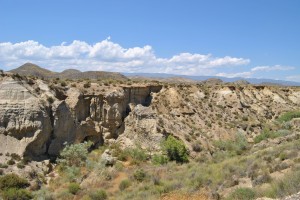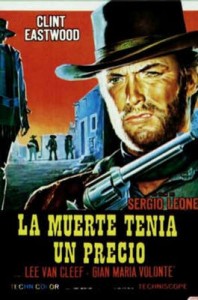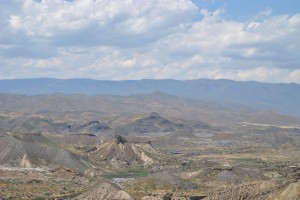Spaghetti Western in Almería Posted by Magda on Jun 9, 2010 in Spanish Culture
¿Qué te sugiere la palabra spaghetti? Seguro que como a mi, deliciosa comida italiana… Pero hay algo más asociado a ella, como veremos.
En pleno corazón de Almería, a 30 Km. de la capital, y a una altitud de 404 metros se encuentra un paraje natural impresionante, el Desierto de Tabernas. Situado entre la Alpujarra Almeriense y la costa, este paisaje desértico parece arrancado de Arizona, Texas o Nuevo México, y colocado en este rincón de Andalucía. Se trata de un lugar impresionante para hacer turismo, no solo por el majestuoso paisaje en si, sino por su propia historia: de entrada tropezamos, vigilando el horizonte, con las ruinas de un castillo nazarí.
Pero el auténtico atractivo de la zona se encuentra en los diversos poblados del lejano oeste en los que el visitante tiene la sensación de estar a punto de ver aparecer a Clint Eastwood cabalgando en su caballo. Y es que durante años, este fue el escenario para multitud de spaghetti westerns, como se llamó a las cintas rodadas en este lado del océano, lo que dio lugar a la creación de varios escenarios que aun hoy día hacen las delicias de grandes y pequeños.
Se construyeron tres “ciudades” en los años 60, con el beneplácito del régimen franquista, para servir de escenario a multitud de títulos. Eran rodajes baratos, y contaban como extras con los lugareños, algo que aun recuerdan con nostalgia quienes tuvieron esa suerte. El poblado de El Fraile, hoy conocido como MiniHollywood, se construyó para el rodaje de “La muerte tenía un precio” (1965), protagonizada por Clint Eastwood. El siguiente que podemos encontrar es el Texas Hollywood / Fort Bravo, que aparece en La muerte tenía un precio y en El bueno, el feo y el malo (1966), construido en 1963, y que alberga además la ciudad, un fuerte y un poblado mexicano. Y por último, el Western Leone, donde se rodó “Hasta que llegó su hora”(1968) con Henry Fonda y Claudia Cardinale.
Fue el italiano Sergio Leone quien encumbró este género con producciones como las ya mencionadas. Como dato curioso, y obtenido gracias a mi editor, David Carmona, mencionar que las tres películas rodadas en el desierto almeriense Por un puñado de dólares, La muerte tenía un precio y El Bueno, el Feo y el Malo fueron su particular homenaje al cine de Akira Kurosawa y su película Joyimbo. Leone aportó su visión personal a este tipo de cine, pasando de impresionantes panorámicas a primerísimos planos de los personajes, duelos tanto de miradas como con armas, sufriendo las inclemencias del sol del desierto. Personajes marcados por la acción y la violencia, poblaron estos parajes con las composiciones de Ennio Morricone como melodía de fondo. Sus bandas sonoras hicieron que la música cobrase aun más importancia que la propia imagen. Director y músico son las grandes figuras que crearon el género conocido hoy como spaghetti western, (por suprocedencia italiana) dando una buena categoría a estas cintas que tras ellos pasaron a ser de serie B.
Tras estos años dorados, Almería y sus desiertos también se usaron en los rodajes de Cleopatra, Lawrence de Arabia, Patton, Indiana Jones y la última cruzada, 800 balas el homenaje de Alex de la Iglesia a este cine, y un largo etcétera. Como vemos, ¡Almería es de cine!
What does the word “spaghetti” suggest to you? I´m sure you are thinking about delicious Italian pasta, just as I did. But there is something more associated to this term, as you will see.
Right in the middle of Almería, 30 km from the city itself and 404 metres high, there is a fascinating natural reserve, “El Desierto de Tabernas” (Tabernas Desert). Located between the Alpujarra Almeriense and the Mediterranean coast, this desertic landscape looks like it belonged to Arizona, Texas, or New Mexico, and was transplanted to this little Andalusian spot. This is a wonderful place for tourism, not only because of its breathtaking landscape, but also due to its history: the first thing we see when visiting Tabernas, standing guard on the horizon, are the ruins of a castillo nazarí (Nasrid castle).
But the main attraction in this area is a group of far west towns, where you feel like Clint Eastwood is just about to turn up riding on a horse. For several years, these were the filming location for many “Spaghetti westerns”, name given to the westerns filmed in this side of the Atlantic Ocean; as a consequence, some of the settings that were built are still there nowadays, bringing a lot of joy to both adults and children who visit them.
Three different towns were built in the 60s, with the approval of the Franco regime, to be used as settings for a great amount of movies. We are talking about low-budget productions, where local people played minor roles as extras: this is something they love to remember whenever they have the opportunity. El poblado de El Fraile (The Friar’s Village), known today as Mini Hollywood, was built for Sergio Leone’s La muerte tenía un precio (1965) (For a few dollars more). A different one is Texas Hollywood/Fort Bravo, setting for both La muerte tenía un precio and El bueno, el feo y el malo (1966) (The good, the bad, and the ugly), built in 1963, where we can still find a city, a fort, and a ‘Mexican’ village. And the last one, Western Leone, is the place where Hasta que llegó su hora (1968) (Once upon a time in the west) was filmed, with Henry Fonda and Claudia Cardinale playing the lead roles.
Sergio Leone was the Italian director who elevated this genre with such productions as the ones mentioned before. As an anecdote, I’d love to highlight that the three movies filmed in Tabernas Desert, Por un puñado de dólares (1964) (A fistful of dollars), La muerte tenía un precio and El Bueno, el Feo y el Malo, were his particular tribute to Akira Kurosawa’s film, Yojimbo (1961)
Leone provided his own personal interpretation to westerns, switching from incredible panoramic shots to extreme close-ups, intense duels using both eyes and guns, under the suffocating sun. Characters marked by action and violence inhabited these settings with Ennio Morricone’s compositions as harrowing background music. His soundtracks made music almost as important as the images themselves. Both director and composer gave life to what is still known as the spaghetti western (due to their Italian origin), imbuing these movies with a quality that could not be replicated by subsequent examples of this genre, which never amounted to anything more than B-movies.
After this golden age, Almería’s deserts were the setting for many other scenes in movies such as Cleopatra, Lawrence of Arabia, Patton, Indiana Jones and the last crusade, 800 balas (Alex de la Iglesia’s particular homage to spaghetti westerns), and many others. As you can see… Almería breathes cinema!

Build vocabulary, practice pronunciation, and more with Transparent Language Online. Available anytime, anywhere, on any device.







